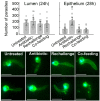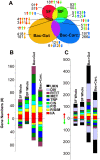Implication of the mosquito midgut microbiota in the defense against malaria parasites
- PMID: 19424427
- PMCID: PMC2673032
- DOI: 10.1371/journal.ppat.1000423
Implication of the mosquito midgut microbiota in the defense against malaria parasites
Abstract
Malaria-transmitting mosquitoes are continuously exposed to microbes, including their midgut microbiota. This naturally acquired microbial flora can modulate the mosquito's vectorial capacity by inhibiting the development of Plasmodium and other human pathogens through an unknown mechanism. We have undertaken a comprehensive functional genomic approach to elucidate the molecular interplay between the bacterial co-infection and the development of the human malaria parasite Plasmodium falciparum in its natural vector Anopheles gambiae. Global transcription profiling of septic and aseptic mosquitoes identified a significant subset of immune genes that were mostly up-regulated by the mosquito's microbial flora, including several anti-Plasmodium factors. Microbe-free aseptic mosquitoes displayed an increased susceptibility to Plasmodium infection while co-feeding mosquitoes with bacteria and P. falciparum gametocytes resulted in lower than normal infection levels. Infection analyses suggest the bacteria-mediated anti-Plasmodium effect is mediated by the mosquitoes' antimicrobial immune responses, plausibly through activation of basal immunity. We show that the microbiota can modulate the anti-Plasmodium effects of some immune genes. In sum, the microbiota plays an essential role in modulating the mosquito's capacity to sustain Plasmodium infection.
Conflict of interest statement
The authors have declared that no competing interests exist.
Figures







References
-
- Sinden RE, Billingsley PF. Plasmodium invasion of mosquito cells: Hawk or dove? Trends Parasitol. 2001;17:209–212. - PubMed
-
- Ghosh A, Edwards MJ, Jacobs-Lorena M. The journey of the malaria parasite in the mosquito: hopes for the new century. Parasitol Today. 2000;16:196–201. - PubMed
-
- Michel K, Kafatos FC. Mosquito immunity against Plasmodium. Insect Biochem Mol Biol. 2005;35:677–689. - PubMed
-
- Vlachou D, Schlegelmilch T, Christophides GK, Kafatos FC. Functional genomic analysis of midgut epithelial responses in Anopheles during Plasmodium invasion. Curr Biol. 2005;15:1185–1195. - PubMed
-
- Dillon RJ, Dillon VM. The gut bacteria of insects: nonpathogenic interactions. Annu Rev Entomol. 2004;49:71–92. - PubMed
Publication types
MeSH terms
Grants and funding
LinkOut - more resources
Full Text Sources
Other Literature Sources
Medical
Molecular Biology Databases

